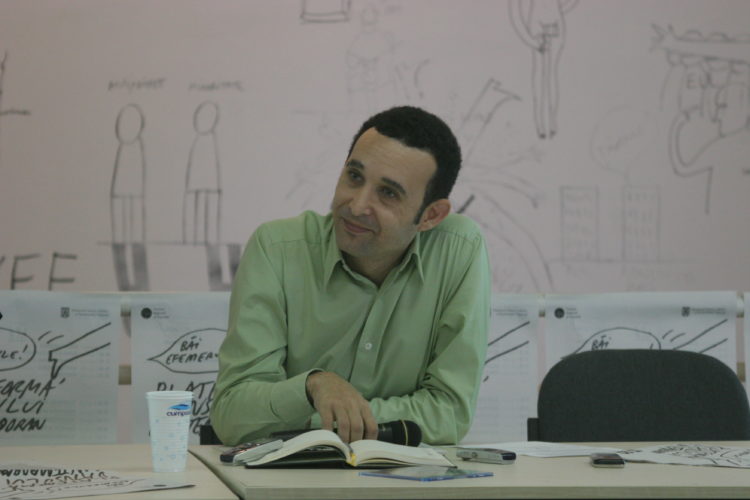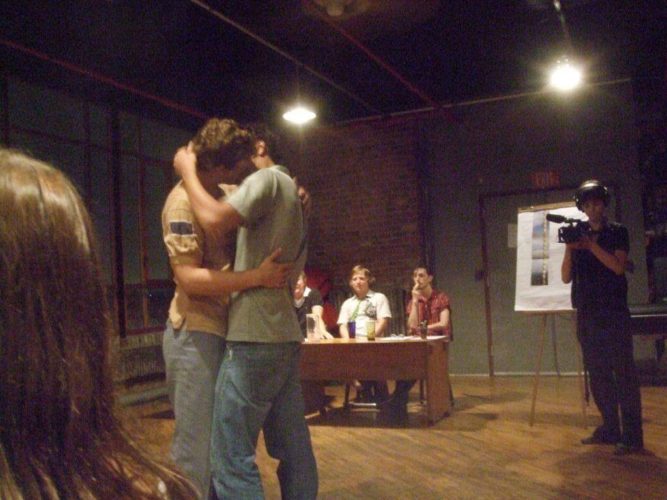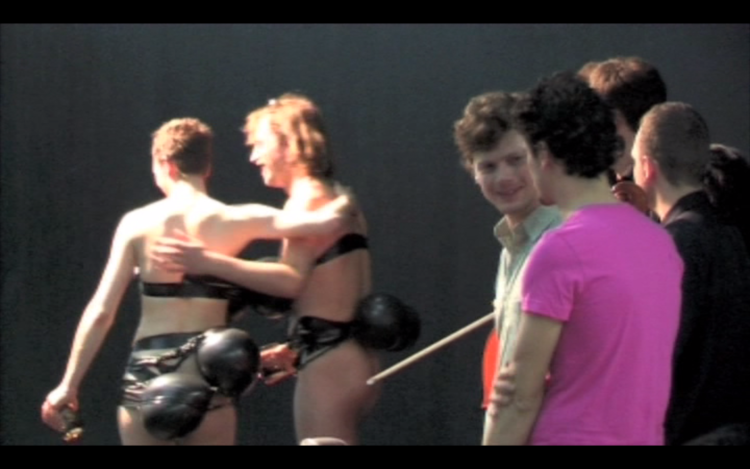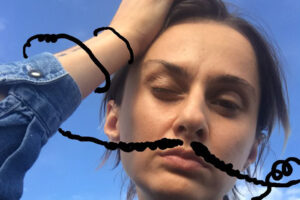February 6, 2019
By Valentina Iancu
Queer Culture in Romania (II)
The institution is the place where the mediation between cultural work and society takes place. The cultural institution in Romania in the 2000s, be it Bucharest or the rest of the country, was distinguished by an automatic conservative hostility towards the production of the new. I say automatic because I doubt that this dominant conservatism is maintained by conviction, rather by the convenience of comfort zones (even if these zones have become outdated and forgotten in the meantime). Communist politicization is now opposed quite strongly by a mimetic depoliticization; equally monotonous. In institutions, culture is being brutally separated from society and funnily isolated in an ivory tower of superior metaphysical mysteries. Most Romanian institutions have been intensively promoting the new wave of national values: cultural conformism, pure aesthetic imitation and ideological alienation. This grim introduction only serves as a gross comparison to properly pave the way for The National Dance Center Bucharest (CNDB).
Dance was obviously only marginally present on the local cultural scene: systemic inadequacy with the program of complementary spaces (theaters, opera), very low access to resources, the absence of a proper space. It can be said that before the mid-2000s, contemporary dance had a similar status to that of gay people in society: invisible.
The founding of the National Dance Center (CNDB) in 2004 [i] came as a natural solution for artists who did not find their place in other state cultural institutions. CNDB immediately became the heart of a community avid for novelty, preoccupied with connecting itself to the practices and theories of the contemporary world. “We started out as artists who had nothing: we struggled for 10 years to survive. For me at least, the institution that CNDB has become during my time as director comes as no surprise since this has been our stance all along. The institution remained open, it drew its artists closer and functioned as a non-hierarchical community. For us the concept of a board was never fictitious: at CNDB the director did not dictate the artistic direction, it was a collective project. I always mediated the bureaucratic side and never abused the power that comes with being a public institution manager. Of course I had a vision, but it also meant opening up to the scene. There was an inclination towards contemporary production, theoretical discussions, and continuous experimentation as go-to solutions” [ii] choreographer Mihai Mihalcea, the institution’s first director, told me a few months back.

MIHAI MIHALCEA, CNDB MANAGER IN 2008 ©ARHIVA CNDB#THE RESOURCE CUBE
CNDB created a revolution within the Romanian cultural scene of 2004. The institution acted as a super-open platform where everything was possible. Cool shows, theoretical discussions, contemporary art exhibitions. Everything appeared and worked differently. CNDB was like an oasis that encouraged everything novel. Mihai Mihalcea opened the institution’s gates towards experimental productions, he remained closely connected to the contemporary and sought to attract the most radical approaches. At that time, the innovation of language, accelerating assimilation, testing the limits of representation were revolutionary concepts. And quite desirable as well.
Naturally, the queer dimension became more and more visible in artistic projects as part of an area of interest in today’s cultural avant-garde. In this sense, the gay kiss performed by Manuel Pelmuş and Brynjar Bandlien was iconic. CNDB’s production shocked the New York audience (a few homophobes from the Romanian diaspora, to be more precise). That moment is part of The Gate of Kiss performance by Manuel Pelmuş and Brynjar Åbel Bandlien in collaboration with Ştefan Tiron and Andy Sinboy at the National Dance Center in Bucharest, during the Zilele strâmbe (Crooked days) festival and later performed at Chez Bushwick in New York with the support of the Romanian Cultural Institute. The performance consisted of a prestigious academic conference about Constantin Brâncuşi and the choreographic enacting of The Gate of Kiss, a part of the monumental ensemble made in Târgu Jiu (now a national symbol). The two choreographers embrace in a natural and very sincere kiss, perhaps shocking due to the lack of artificiality that could have mediated the impact through theatrics. The embraced bodies translated into choreographic language the sculptural shape of Brâncuşi’s simplified kiss, a kiss that was reduced to the essence of the form and thus it had been de-originated.

THE GATE OF KISS, CNDB 2008.
“The Kiss and Brâncuşi became the cultural, historical and political framework for our need to raise certain personal, political and social questions that we consider urgent. [iii]
…
Reenactment as an interrogation of history and the politics of representation.
The kiss as a personal, public and political movement ”
Brynjar Åbel Bandlien and Manuel Pelmuş [iv]
The queer appropriation of “national values” through gay enacting produces a transgression (only) in front of a homophobic audience. Performance has become revolutionary through the radicalism with which a simple gesture has succeeded in shattering the comfort of viewers, upsetting them, and making them retaliate in the media. Manuel Pelmuş’s transgression reaffirmed the limited presence of non-heterosexual sexuality in the public space, which is strongly rooted in the norms of today’s Romanian society. According to Foucault, transgression looks at the limit it affirms precisely through the gesture of breaking it. The Brâncuşi phenomenon conjugated to homosexuality is a calculated shock. A ticking time bomb. “Because Brâncuşi is not a cultural and national value, because Brâncuşi represented from the very beginning two beautiful men kissing under the Gate of Kiss, because we were both exiled, because we were also rejected, because neither he nor we work to represent the country, we are not messengers, diplomats, publishers or travel agents, we are not Romanians present abroad to wash away the shame of those who have enslaved and exterminated us, neither do any of us promote you, nor do we create beautiful objects” wrote Cosmin Costinaş in the Strimb Manifesto (Crooked Manifesto). In New York, the homophobic audience left the room. Then the Romanian diaspora’s press, followed by the country’s own press, immediately attacked the banal kiss between the two choreographers and called it the “kiss of death.” The scandal engineered by homophobes managed to shed some light on the piece’s transgressive dimension, at the same time making it stick to the collective memory. Interestingly enough, at CNDB where the performance had taken place just a few months prior, the audience did not appear to be shocked. Or in any case no one twisted a visual shock into a homophobic attack. CNDB was a safe space that attracted a supportive audience rather than a consumerist one. The performance piece was part of the first queer micro-festival, Zilele strâmbe (Crooked days), proposed by choreographer Brynjar Åbel Bandlien within the CNDB’s Amprenta program. Amprenta is a curatorial format where choreographers are invited
to present and represent themselves and also showcase other creators who have influenced them. Zilele strâmbe featured the premiere of Still by Brynjar Åbel Bandlien, the now famous Gate of Kiss, the futuristic Doomsday machine by Pedro Gomez Egana, The Part and Mary’s Dance by Antonjiei Livingstone, the Dance (Practicable) experiment by Federuc Gies; a series of crooked workshops, a night of crooked films, a Saturday dedicated to sound art and a party at the end. “What surprised me when I saw the list of artists was that the people who inspire me, influence me and whom I find important to showcase here in Romania are all Americans who live in Europe and have a crooked identity.”[v]

BYNJAR BANDLEN ATTENDING „THE PART” PERFORMANCE BY ANTONIJA LIVINGSTONE AT “ZILELE STRÂMBE” FESTIVAL, CNDB, BUCHAREST 2008 ©ARHIVA CNDB#THE RESOURCE CUBE
The first large queer project within a national institution attempted to introduce the term crooked, the equivalent for (the more prominent term) queer, in the vocabulary of contemporary culture. The Crooked Manifesto signed by Cosmin Costinaş, printed in the publication accompanying the event, puts forward the principles with which it operates: crooked is revolutionary, it affirms diversity, it counteracts nationalism. The crooked stand in opposition, in the shadows. A word that easily performs all syntactic functions: it embraces both plasticity and references to the policies of correcting non-conforming manifestations of bodies, thus opening the possibility of identifying a conceptual language in Romanian. The phrase “a călca strâmb” (roughly translated as making a wrong move) is recurrent in church and religious language and refers to deviating from the sexual norm. Crooked symbolizes difference, the unacceptable that must be corrected and straightened out. Crooked does not exclusively refer to homosexuality; it is a theoretical space that includes the unacceptable and allows it to manifest itself. And placing this possibility within a national institution was possible, as Brynjar Åbel Bandlien mentioned in the event’s publication: “this probably was the first time the Ministry had hired someone who just one year earlier had performed in drag in front of the Ministry of Culture, exuding Fuck posterity, I want to dance now!”
(To be continued)
[i] By LAW no. 1.123 of 15 July 2004.
[ii] Mihai Mihalcea during a recorded discussion in Cișmigiu park, 13.04.2018.
[iii] Cosmin Costinaș The Crooked Manifesto in the booklet for Cursul Zilelor Strâmbe, CNDB, 2018.
[iv] Cursul Zilelor Strâmbe, CNDB, 2018.
[v] Bynjar Bandlen Bynjar Bandlen in the booklet for Cursul zilelor strâmbe.
POSTED BY
Valentina Iancu
Valentina Iancu (b. 1985) is a writer with studies in art history and image theory. Her practice is hybrid, research-based, divided between editorial, educational, curatorial or management activities ...



